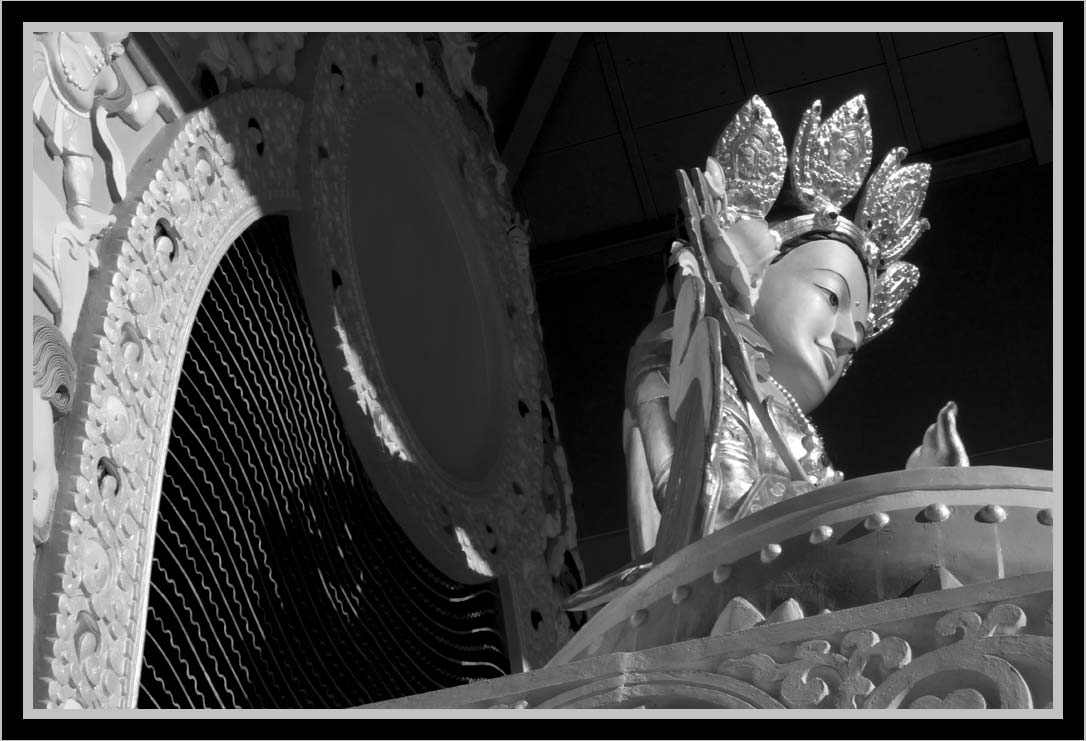

YUM CHENMO—"Great Wisdom Mother" [ click photo for next . . . ]
EWAM, Garden of 1000 Buddhas, Jocko Valley, Arlee Montana
On the road in the Northwest of America.


YUM CHENMO—"Great Wisdom Mother" [ click photo for next . . . ]
EWAM, Garden of 1000 Buddhas, Jocko Valley, Arlee Montana
On the road in the Northwest of America.
Every well-made path
was once only a possibility.
Because it is well-made,
daily use only
makes it more beautiful.
| If you're interested in philosophy and the general background
to the present crisis of perception, culture and consciousness,
please preview my little book, THEATER OF THE NEW. |
| my webpage for THEATER OF THE NEW | facebook page |
Follow @cliffcrego
A QUESTION OF NON-VIOLENCE,
OR NON-EXISTENCE—a meditation
As I was working on the third revision of my little book for the
picture-poems.com project, THEATER OF THE NEW,
I had a chance to watch, The Sun Behind the Clouds: Tibet’s
Struggle for Freedom. (Ritu Sarin / Tenzing Sonam 2010)The central fact of the film, it seems to me, is the
brutal two-step, clearly illegal, occupation of Tibet
in 1951 and 1959 by the then old-style communist
regime of China.There are many possible responses to this fact:
There is the path of violent resistance to the Chinese occupiers,
an approach being increasingly favored by young Tibetans,
both in- and outside of the country. (This is understandable.
Since 1959, the situation has only gotten very much worse.)In contrast, we have the path of non-violence, which comes
naturally out of Buddhist culture generally, and in a
remarkably gentle yet steadfast way has been
embodied consistently and powerfully by the Dalai Lama.
This latter path of non-violence is called by His Holiness
himself, “the middle way.” This is because, politically,
it takes bitter compromise as its point of departure. It is
'bitter' because it is, in my view, self-evidently unjust.
Ethically, without a doubt, the Chinese regime’s—not the
Chinese people, but the current government—use of
force in Tibet cannot be justified.
If there were truly worldwide rule of law, this would not
be tolerated. But this is not so. So the Dalai Lama has no
alternative but to “bargain with the devil,” so to speak.
This, it seems to me, is because the conscience of
the world has failed him. At least up to now.The question which instantly comes to mind is, why
did satyagraha, the way of ‘obstinate truth,’ of
Gandhi not fail? Or twenty years later, on a different
continent, why did the militant non-violence of
Dr. King also not fail?This, of course, is the question that makes this
documentary so relevant given the current world
situation.In my view, the path of the Dalai Lama is in
one fundamental sense not a middle way; it
does not — and this is crucially important — it
does not compromise on its commitment to
non-violence.The Dalai Lama has not failed. It is we, as a world
community, who have failed.Gandhi, embodying truth, took his stance squarely
blocking the ruthless rule of British Empire, and the
whole world said, “Stop!” King, embodying truth
in his own way and facing a similar divisive urge
to violent protest in his own racial justice movement,
stood his ground, and the whole world said, “This
must stop!”So again, we might say that the Dalai Lama has not
failed. Rather, it is we, as a world community, who have failed.
Both him, and ourselves. Why? Because non-violence
is always a question of the individual passively resisting force
together with the consciousness of the world, as a kind
of collective intelligence or lens of compassion,
witnessing the individual's action. It is a necessary unity.So, The Sun Behind the Clouds is truly a film to
meditate upon.In metaphysical terms, I feel that there is a great and
tragic lack of clarity when it comes to the idea of using
what is seen as justifiable violence to come
to order and peace. [It has also become the central
issue of the Occupy movement, worldwide.]
This confusion is as tragic as it is unfortunate. And it is
especially true in North America, where in contrast
to Japan and Europe, and increasingly in South
America, war and the use of force generally is, in
diplomatic terms, not seen as a justifiable alternative.Now, a key question of philosophy is necessity,
the things of the world that ‘cannot be otherwise.’
Is non-violence an absolute necessity?
Yes, I think it is.
That means there is no other way, middle, or
otherwise.This was the key insight of Dr. King, uttered
in a remarkable address to the world just hours
before he was to be assassinated:“Only when it is dark enough, can you see the stars …
Men for years now have been talking about War and Peace,
but now no longer can they just talk about it. It is no longer
the choice between violence and non-violence in this world;
it’s non-violence or non-existence.”This has become, I think, the central and most profound
truth of our time.
from Dr. Martin Luther King, Jr.’s last major address,
April 3rd, 1968, “I Have Been to the Mountain Top.”
If you're a picture-poems fan, please visit my Living Water
Gallery—the best of my flowform photography w/ a selection
of quality prints & frames . . .
[ mouse over for controls / lower right fro full-screen ]

All Photographs & texts by Cliff Crego © 1999-2014 picture-poems.com
(created: I.2.2012)